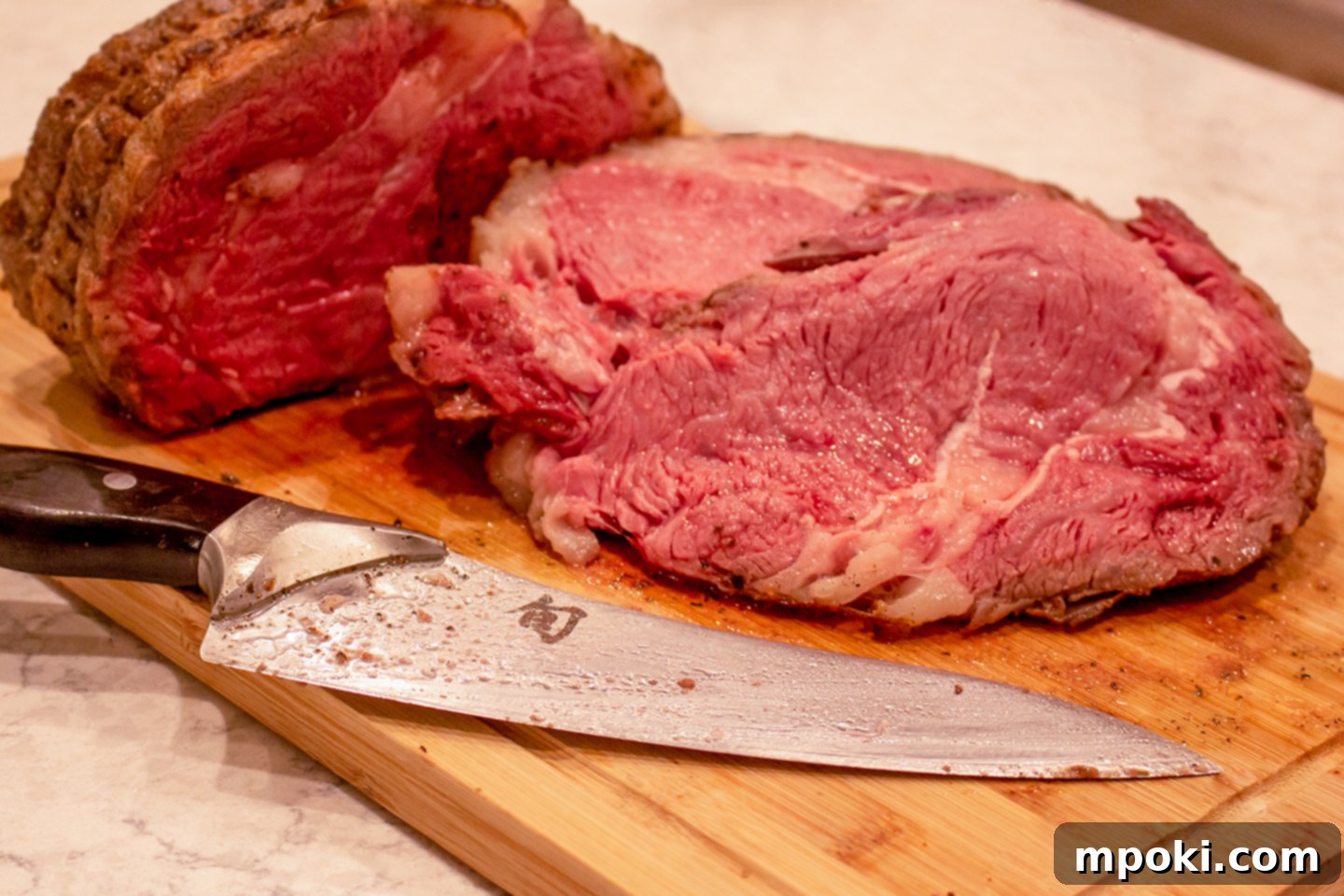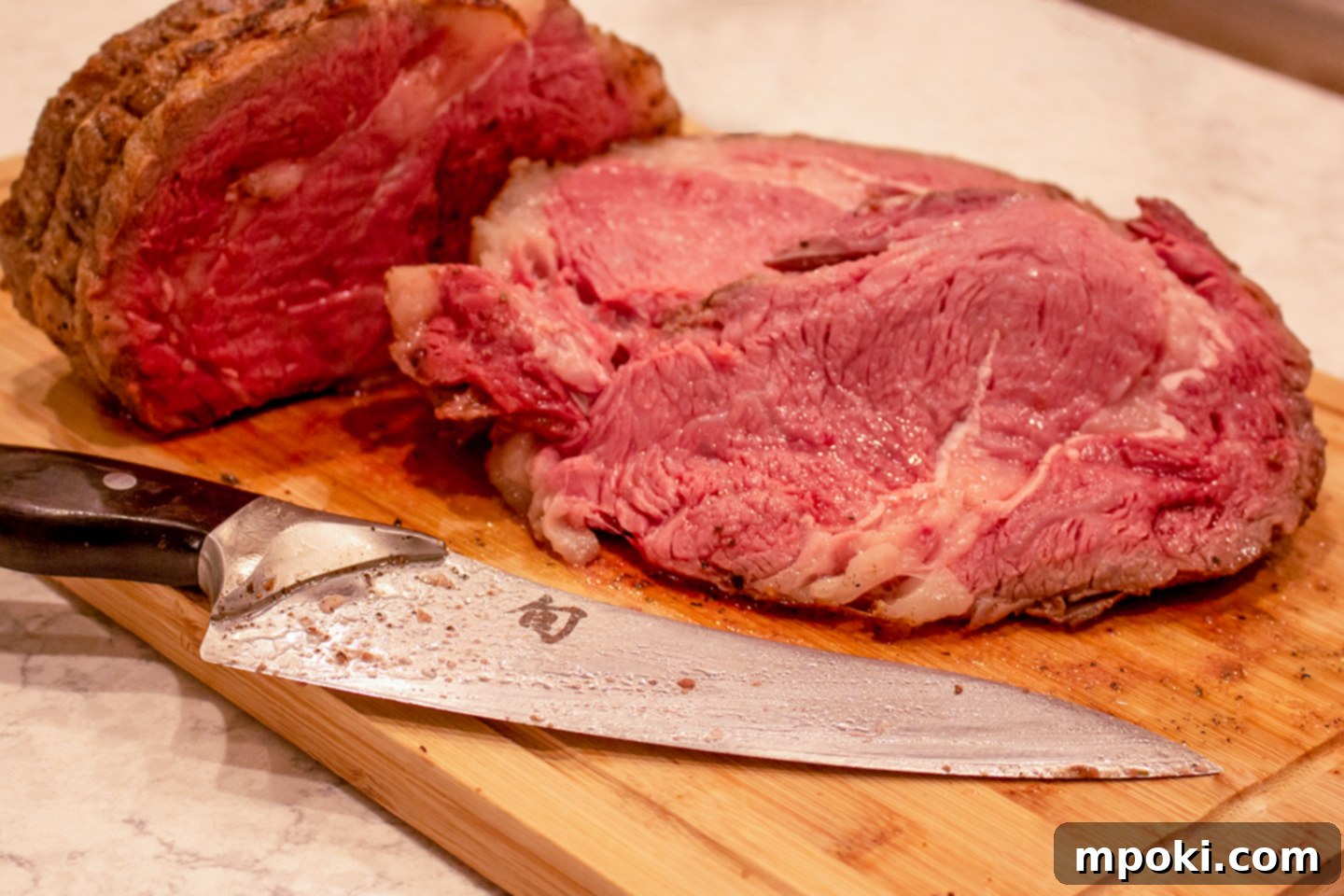
Mastering Sous Vide Prime Rib: The Ultimate Guide to a Flawless Roast
Cooking a magnificent prime rib roast can often feel like a culinary challenge reserved for professional chefs. However, with the innovative sous vide method, you can achieve restaurant-quality results in your own kitchen with surprising ease. Imagine a prime rib that is incredibly tender, perfectly cooked from edge to edge, and bursting with rich, beefy flavor. This isn’t just a dream; it’s a guarantee with sous vide cooking.
This comprehensive guide will walk you through every step of creating an unforgettable Sous Vide Prime Rib, transforming a daunting holiday centerpiece or special occasion meal into a simple, enjoyable process. Forget the guesswork, the constant oven checks, and the fear of overcooking. Sous vide offers unparalleled precision, ensuring your prime rib is always juicy, tender, and exactly to your desired doneness.
Whether you’re a seasoned sous vide enthusiast or new to the technique, this recipe will empower you to deliver a prime rib that will impress even the most discerning palates. So, let’s dive into the world of precise temperature cooking and unlock the secret to the most fantastic prime rib you’ll ever taste!
This Page Contains Affiliate Links. For more Info See My Disclosures here.
Why Sous Vide Prime Rib is a Game-Changer for Perfect Roasts
Sous vide cooking, meaning “under vacuum” in French, is a culinary technique that involves vacuum-sealing food in a bag and then cooking it in a precisely temperature-controlled water bath. This method is especially revolutionary for large cuts of meat like prime rib, where achieving uniform doneness and exceptional tenderness can be notoriously difficult with traditional cooking methods.
Here’s why sous vide makes preparing an amazing prime rib roast incredibly easy and consistently yields spectacular results:
- Precision Temperature Control: The water bath maintains an exact temperature, cooking your prime rib to your desired doneness (e.g., medium-rare at 131°F / 55°C) from the very center to the outer edges. This eliminates the dreaded grey band often seen in oven-roasted meats, ensuring every slice is perfectly pink and juicy.
- Foolproof Cooking: It’s virtually impossible to overcook your prime rib with sous vide. Once the internal temperature of the meat reaches the set water bath temperature, it will hold that temperature without going higher. This wide window of flexibility means you can cook your prime rib for several hours without fear of drying it out, giving you more freedom to time your meal perfectly.
- Unmatched Tenderness: Longer cooking times in the sous vide bath, even at relatively low temperatures, allow connective tissues within the prime rib to break down without causing the muscle fibers to toughen. This results in an incredibly tender roast that often surpasses what can be achieved with conventional methods.
- Enhanced Flavor and Juiciness: Cooking in a sealed bag prevents moisture and flavor from escaping. All the natural juices and seasonings remain with the meat, intensifying its rich flavor profile and ensuring a supremely moist and succulent prime rib.
- Reduced Stress: With the sous vide bath handling the precise cooking, you’re free to focus on other aspects of your meal preparation, side dishes, or simply enjoying time with your guests. The final sear is a quick, high-heat step that delivers a beautiful crust without affecting the perfectly cooked interior.
If you’re interested in learning more about the fundamental principles of sous vide cooking, including equipment and basic techniques, be sure to explore Dad’s Guide to Sous Vide Cooking. For this recipe, we’ll assume you have a basic understanding of how your sous vide machine operates.
Essential Equipment for Sous Vide Prime Rib
To embark on your journey to the perfect sous vide prime rib, you’ll need a few key pieces of equipment. Most of these are standard for sous vide cooking, but let’s review them to ensure you’re fully prepared.
- Sous Vide Cooker (Immersion Circulator): This is the heart of your setup. An immersion circulator heats and circulates water to maintain a precise temperature. Popular brands include Anova, Joule, and Instant Pot Accu Slim.
- Large Container or Pot: You’ll need a container big enough to fully submerge your entire prime rib roast. A large stockpot or a dedicated polycarbonate sous vide container works perfectly. Ensure it has enough volume to allow water to circulate freely around the roast.
- Vacuum Sealer & Bags: A vacuum sealer is crucial for removing air from the bag, which ensures efficient heat transfer from the water bath to the meat. High-quality vacuum bags are food-safe and designed to withstand the heat of the water bath. If you don’t have a vacuum sealer, you can use the water displacement method with a high-quality freezer bag (like Ziploc), but a vacuum sealer is highly recommended for best results, especially with large cuts like prime rib.
- Butcher’s Twine: This is used for trussing the prime rib, helping it maintain its shape during the long cooking process.
- Baking Sheet with Wire Rack or Roasting Pan: Essential for drying the roast and for the final searing step under the broiler. The wire rack allows for even air circulation and prevents the bottom of the roast from steaming.
Having these tools ready will streamline your cooking process and help you achieve flawless results.
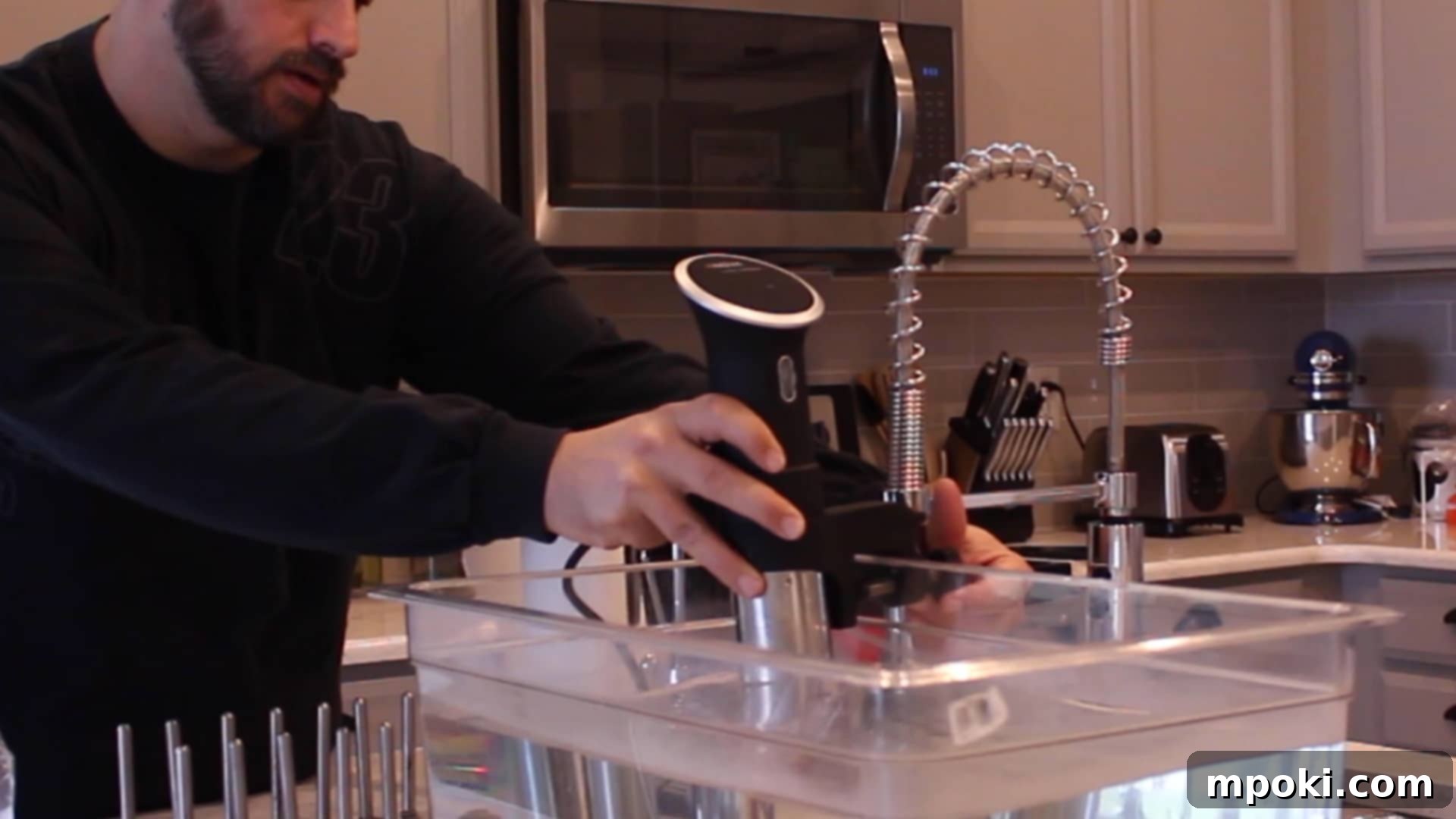
Step-by-Step: Preparing Your Sous Vide Prime Rib
The process of making sous vide prime rib is straightforward, consisting of just a few key stages: preparation, sous vide cooking, and a final sear. Each step contributes to the incredible tenderness and flavor of the final dish.
1. Set Up the Water Bath
Begin by preparing your water bath. Select a container that is large enough to comfortably fit your prime rib roast with ample room for water to circulate around it. A large stockpot or a dedicated polycarbonate sous vide container are excellent choices.
Fill the container with water. Attach your sous vide immersion circulator to the side of the container according to the manufacturer’s instructions. Turn on the sous vide cooker and set the target temperature to 131 degrees Fahrenheit (55 degrees Celsius). This temperature will yield a perfect medium-rare prime rib, which is often considered the ideal doneness for this cut, maximizing tenderness and juiciness. Allow the water bath to come up to temperature while you prepare the roast.
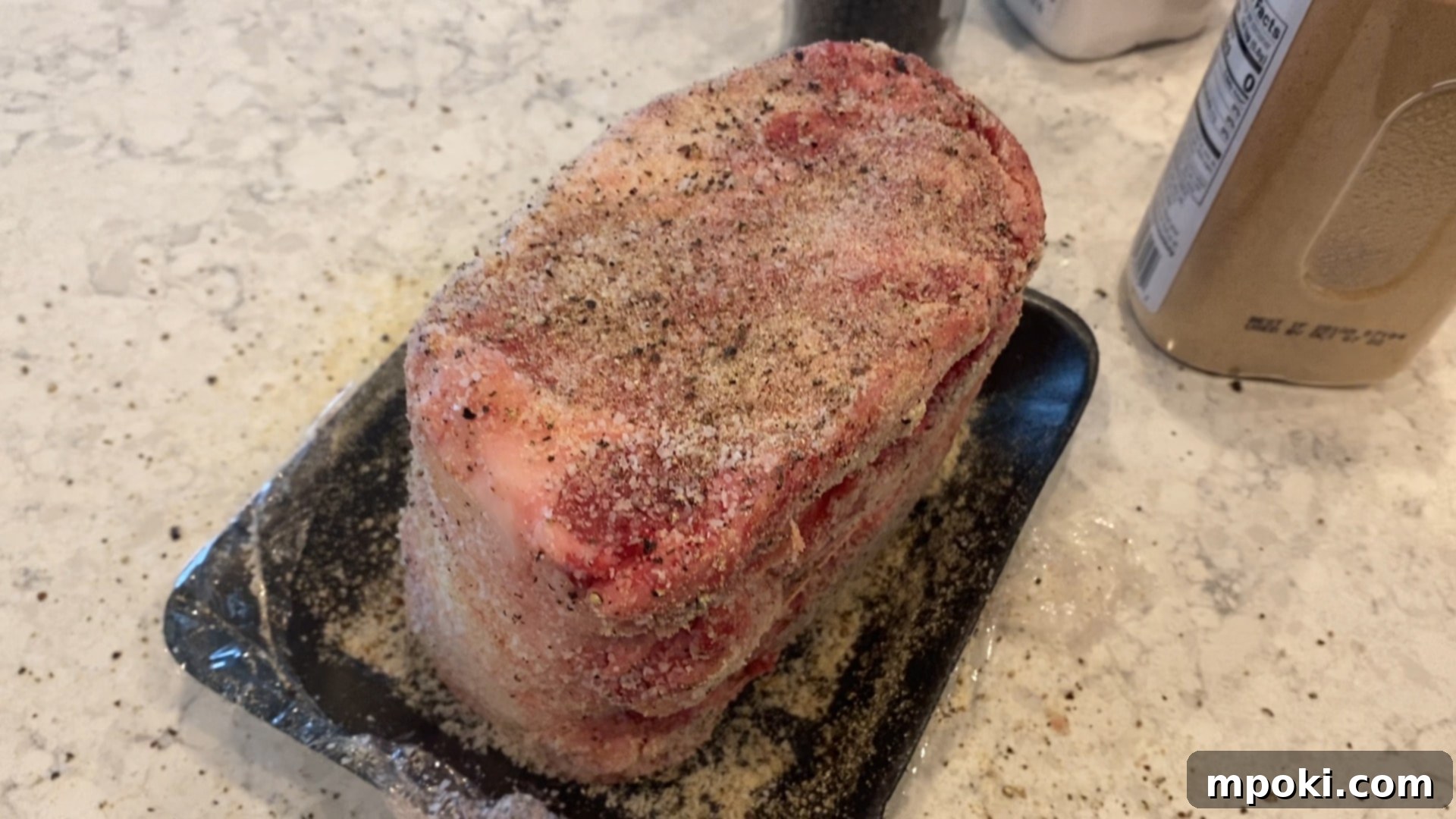
2. Prepare and Season the Prime Rib
While your water bath is heating, turn your attention to the prime rib. If your prime rib roast is not already trussed, take a moment to tie it with butcher’s string. Trussing helps the roast maintain a uniform shape throughout the long cooking process, ensuring even cooking and a more appealing presentation when sliced. It also helps keep any loose sections together once it’s removed from the bag.
Next, it’s time to generously season your prime rib. For a classic flavor profile that truly highlights the beef, season liberally with salt, black pepper, garlic powder, and onion powder. Don’t be shy with the seasoning; prime rib is a large, thick cut of beef that can handle a substantial amount of flavor. This initial seasoning will permeate the meat during the sous vide process, creating a deep, savory foundation. You can also experiment with other herbs like rosemary or thyme, or a specialty beef rub, if desired.
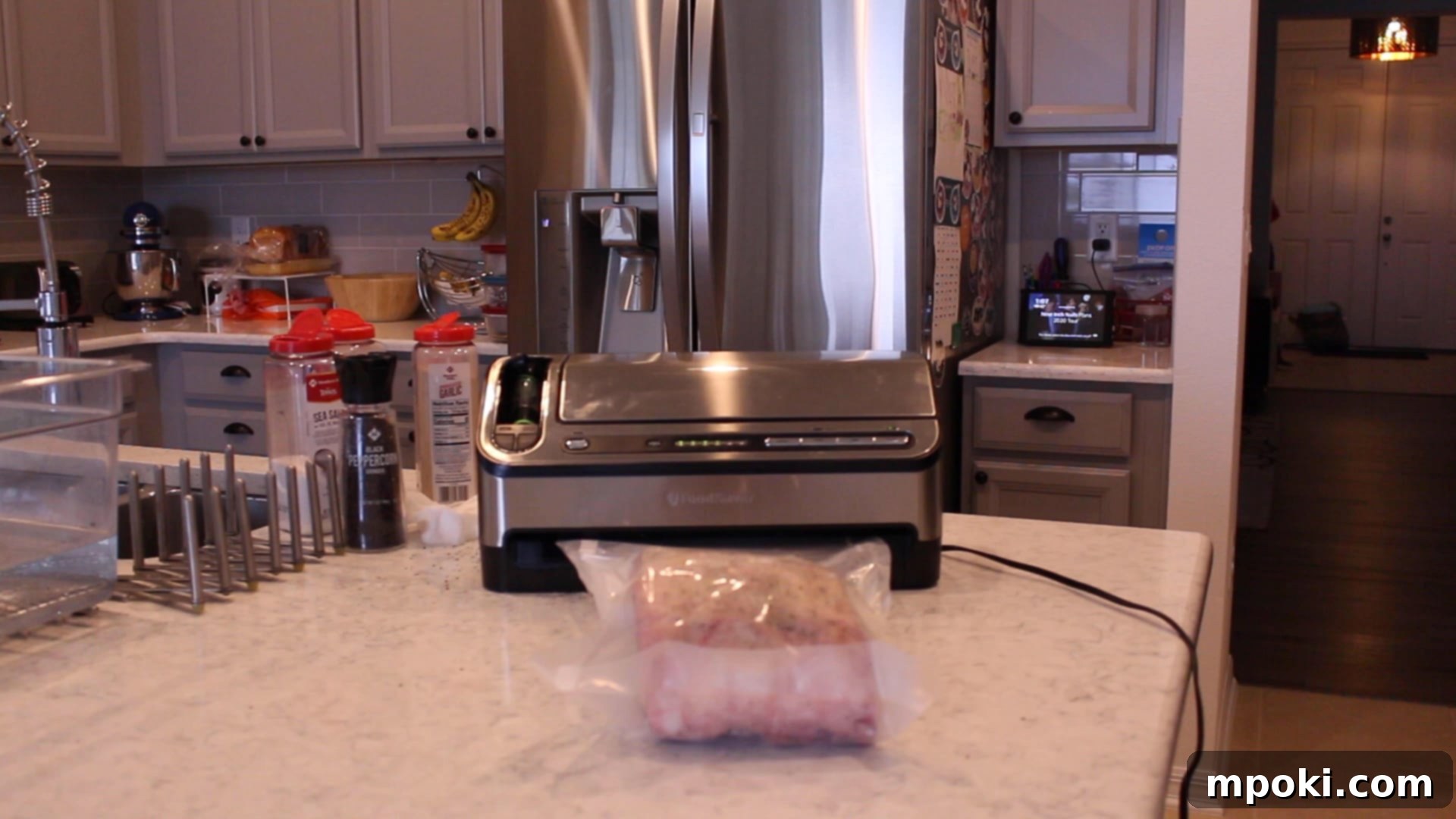
3. Vacuum Seal the Roast
Once seasoned, carefully place the prime rib inside a vacuum-sealable bag. Ensure the roast lies flat within the bag without excessive bunching. Use your vacuum sealer to remove all the air from the bag and create a tight seal. A proper vacuum seal is critical for efficient heat transfer and to prevent the roast from floating in the water bath. If you’re using the water displacement method with a freezer bag, submerge the bag slowly into the water, allowing the water pressure to push out the air before sealing it almost completely at the waterline.
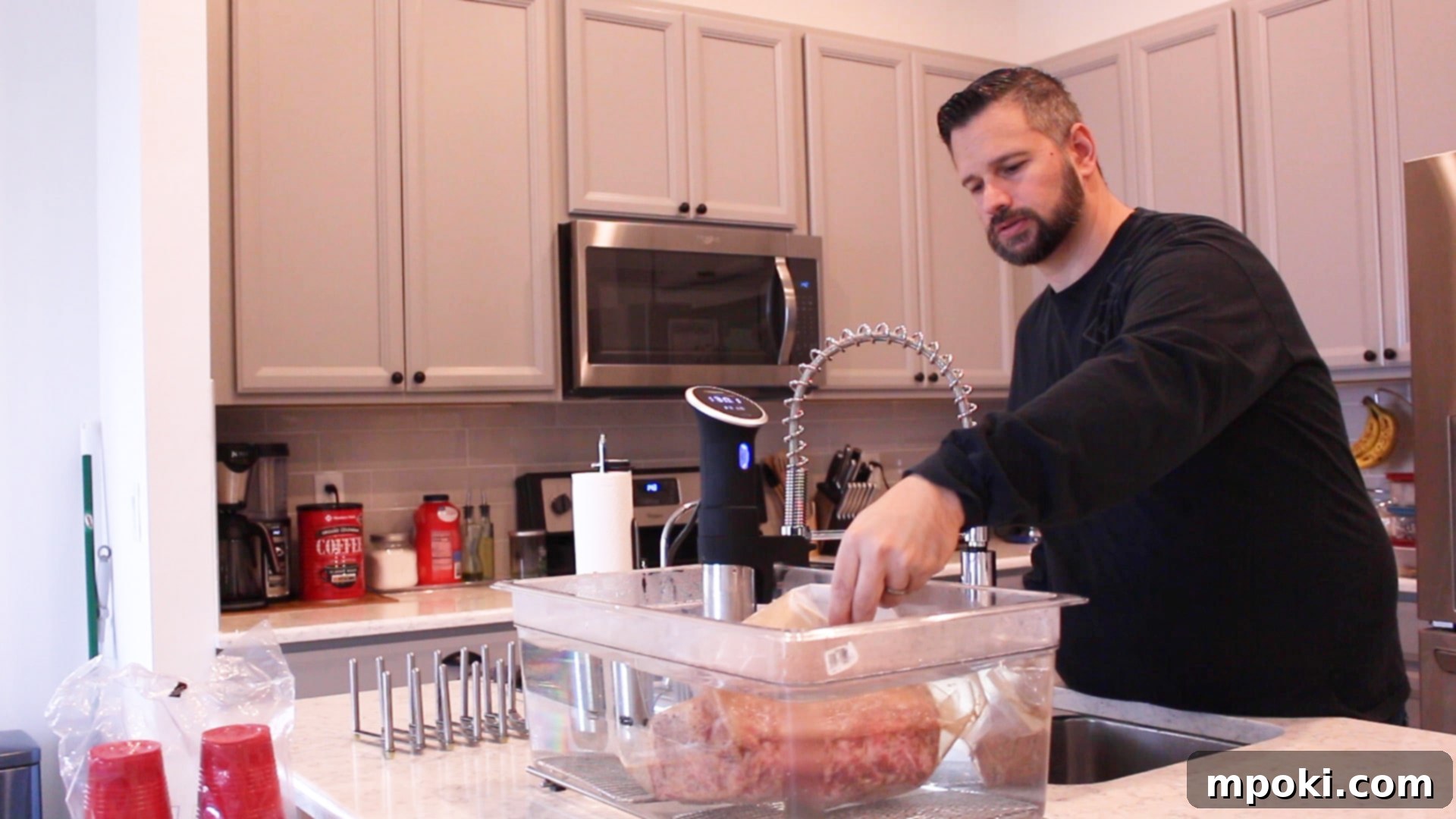
4. Sous Vide Cooking
When the water bath reaches the target temperature of 131°F (55°C), carefully place the vacuum-sealed prime rib into the bath. It is crucial that the entire prime rib is fully submerged in the water for even cooking. Depending on your container and the type of bag, you might clip the bag to the side of the container to prevent it from floating. If the roast tends to float, you can use a heavy ceramic plate or a weighted sous vide rack to keep it submerged. Ensuring full submersion prevents uneven cooking.
Now comes the “set it and forget it” part of sous vide. Cook the prime rib for a duration between 4 to 10 hours. This may seem like a wide time window, but it’s one of the beauties of sous vide. The minimum cooking time ensures the roast reaches the desired internal temperature. Cooking for longer, up to 10 hours, further tenderizes the meat by breaking down connective tissues without making the meat dry or overcooked, thanks to the precise temperature control. For a perfectly tender yet still firm texture, an 8-hour cook time is often ideal, offering a luxurious “tear-apart” tenderness while maintaining a beautiful medium-rare center.
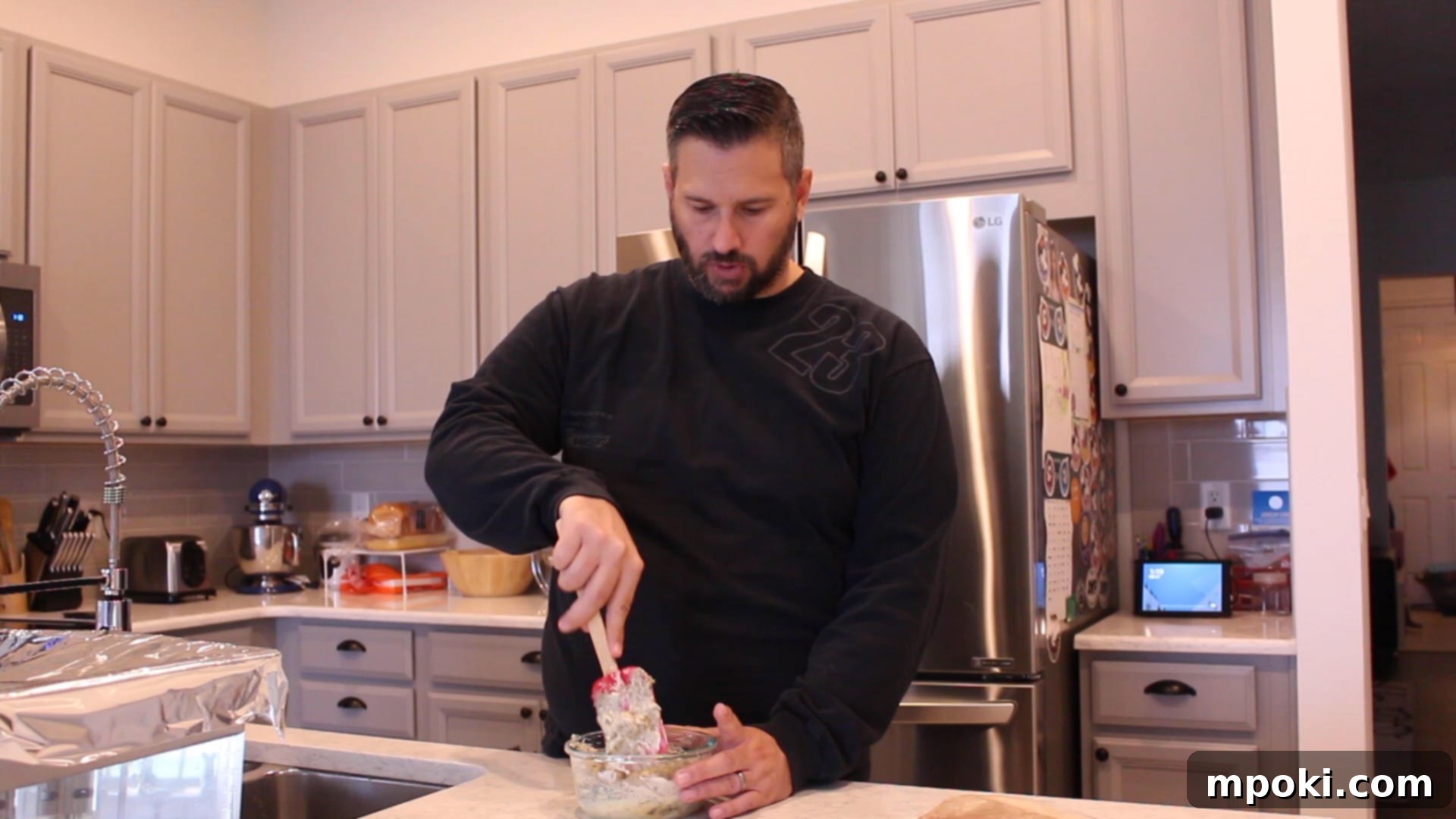
5. Prepare the Herb Butter
About an hour before your prime rib is scheduled to finish its sous vide bath, prepare the aromatic herb butter. Take two 4-ounce (113g) sticks of unsalted butter and allow them to come to room temperature to soften. If you’re short on time, you can gently microwave them for 10-20 seconds until soft but not melted.
In a small bowl, combine the softened butter with 1 tablespoon of garlic powder, 1 tablespoon of onion powder, 1 tablespoon of dried oregano, and 1 tablespoon of dried basil. Mix thoroughly until all the herbs and spices are evenly incorporated into the butter. This herb butter will be essential for creating an incredible crust and adding a final layer of flavor during the searing process. While you wait for the prime rib, you can store this herb butter in the fridge, then take it out an hour before searing to ensure it’s spreadable.
At this time, also preheat your oven to the highest broiler setting. You want your oven to be as hot as possible for the searing step to quickly develop a rich, browned crust.
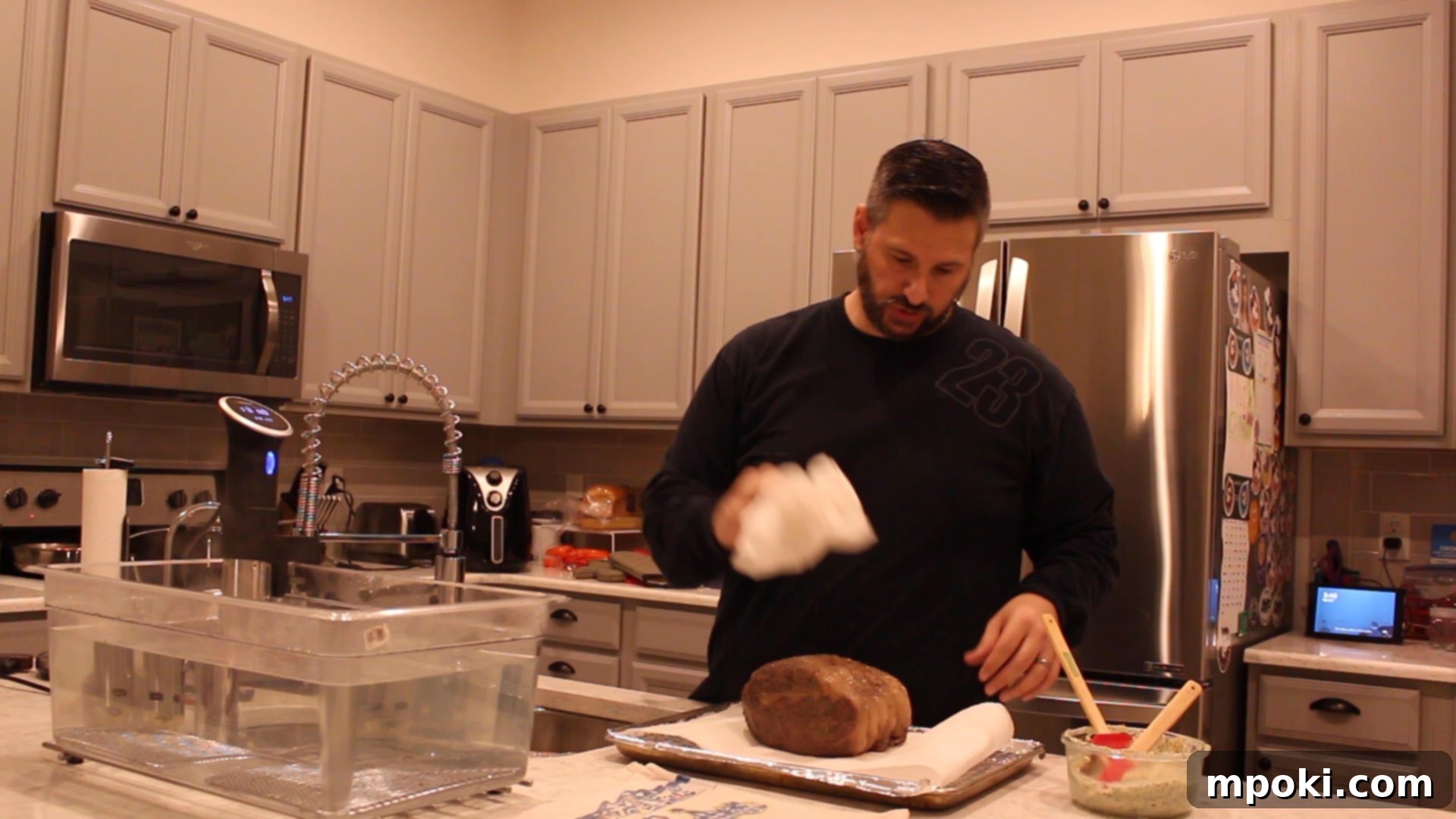
6. Dry the Roast Thoroughly
Once the desired sous vide cooking time has elapsed, carefully remove the bag from the water bath. Transfer the prime rib from the bag onto a baking sheet fitted with a wire rack. This setup allows for optimal air circulation around the roast.
The most critical step before searing is to thoroughly dry the exterior of the prime rib. Use paper towels to pat the entire surface of the roast until it is as dry as possible. Any residual moisture on the surface will create steam when exposed to high heat, preventing the formation of a desirable, crispy crust. A dry surface is key to achieving that beautiful, deep brown sear.
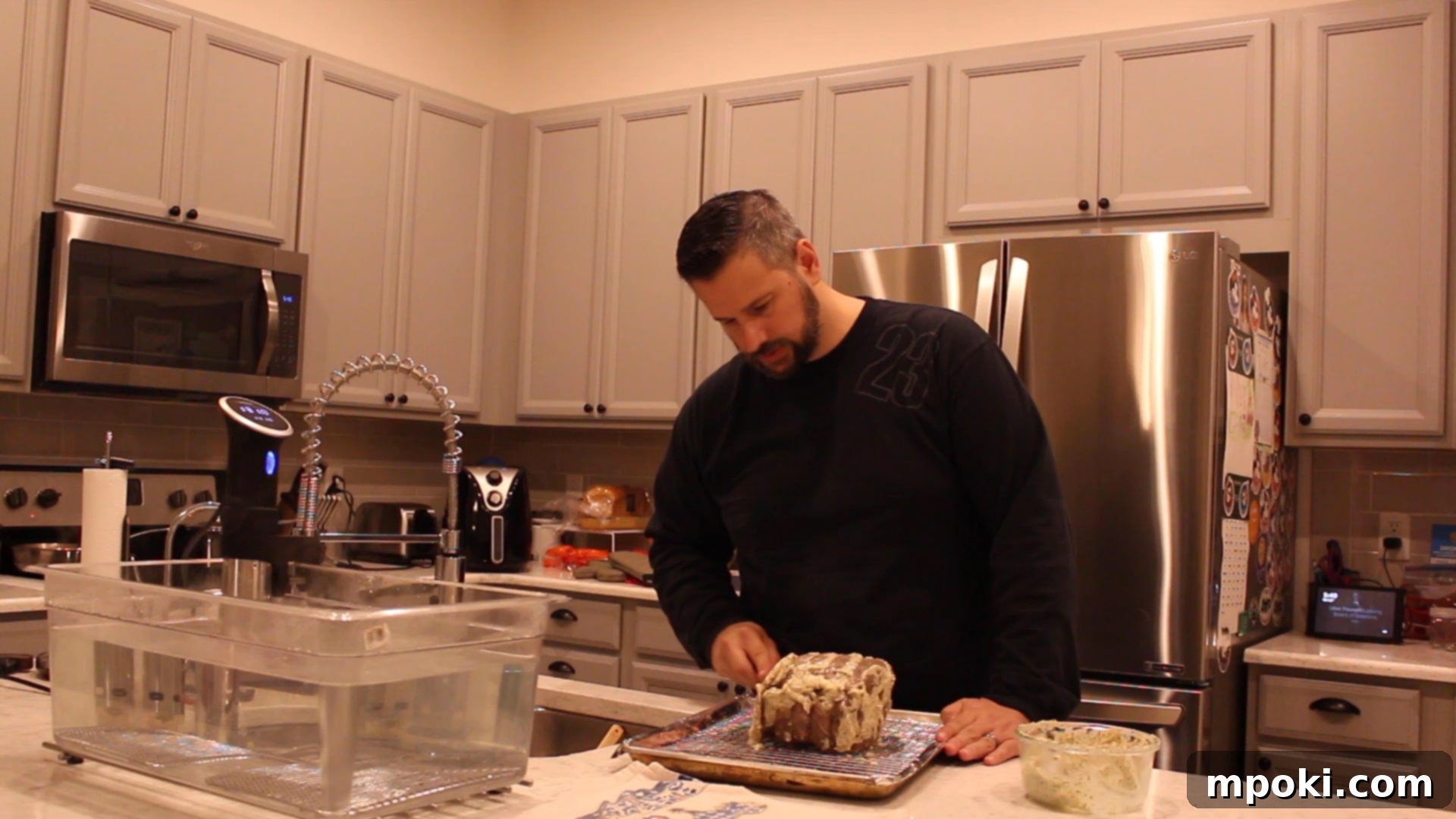
7. Apply Herb Butter and Sear
With the prime rib thoroughly dried, generously spread the prepared herb butter all over the entire surface of the roast. Because the roast is warm from the sous vide bath, the butter will naturally begin to melt as you spread it. This is perfectly fine; simply ensure the entire prime rib is well coated. The herb butter will not only contribute immense flavor but also aid in achieving a superior, flavorful crust during the searing process.
Place the buttered prime rib under the preheated broiler. Cook for 10-15 minutes, turning the roast as needed to brown all sides evenly. The exact time will depend on your broiler’s intensity and how close the roast is to the heating element. What’s most important here is the color, not the clock. You’re looking for a beautiful, deep brown, caramelized crust to form on all sides. Be vigilant during this step; high heat can quickly turn from perfect sear to burnt. This is the only stage where you can genuinely overcook your sous vide prime rib, so watch it closely and pull it from the oven once that gorgeous crust is achieved.
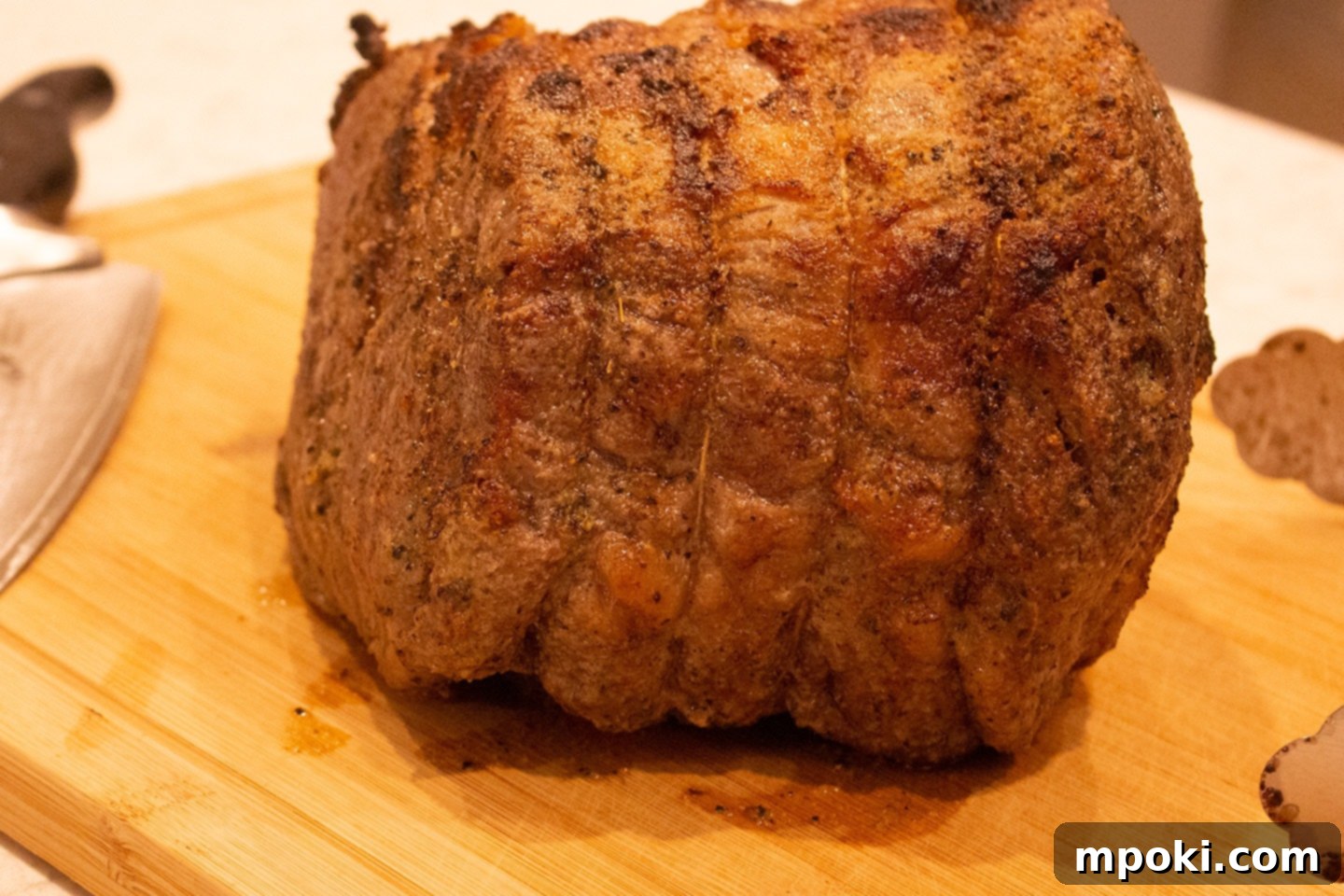
8. Carve and Serve Immediately
One of the fantastic advantages of sous vide cooking is that there is absolutely no need to rest the prime rib after searing. Because the meat cooks slowly and evenly in its own juices, the muscle fibers are relaxed, and the juices are already evenly distributed throughout the roast. Traditional resting periods are designed to allow juices to redistribute in conventionally cooked meats, but this isn’t necessary with sous vide.
As soon as your prime rib has achieved its perfect golden-brown crust, remove it from the oven, transfer it to a cutting board, and carve it into thick, glorious slices. Serve immediately and prepare for an exceptional dining experience!
Sous Vide Prime Rib Recipe
This simple yet highly effective recipe for sous vide prime rib delivers a tender, juicy, and flavor-packed roast every single time. The sous vide method makes it virtually impossible to overcook your prime rib, ensuring a perfect medium-rare from edge to edge. Once the beef has cooked to perfection in the water bath, all that’s left is a quick sear in the oven to develop a beautiful, irresistible crust.
Rating: 5 out of 5 stars (from 1 vote)
Print Recipe | Pin Recipe | Rate This Recipe
Course: Main Course | Cuisine: American | Keyword: prime rib, Sous Vide
Prep Time: 10 minutes | Cook Time: 4-10 hours | Searing Time: 10-15 minutes | Total Time: Approximately 4 hours 25 minutes (based on 4-hour cook time + 15 min sear + 10 min prep)
Servings: 6
Author: Dad
Equipment
- Sous Vide Cooker (Immersion Circulator)
- Large Pot or Polycarbonate Container
- Sheet Pan with Wire Rack or Roasting Pan
- Vacuum Sealer & Bags (or high-quality freezer bags for water displacement method)
Ingredients
- 6 lb Boneless Prime Rib Roast
- 4 tablespoons Salt (Estimate – Season Liberally)
- 4 tablespoons Garlic Powder (Estimate – Season Liberally)
- 4 tablespoons Onion Powder (Estimate – Season Liberally)
- 2 tablespoons Black Pepper (Estimate – Season Liberally)
- 8 oz Unsalted Butter (for herb butter)
- 1 tablespoon Garlic Powder (for herb butter)
- 1 tablespoon Onion Powder (for herb butter)
- 1 tablespoon Oregano (for herb butter)
- 1 tablespoon Basil (for herb butter)
Instructions
- If your prime rib roast is not already trussed, go ahead and truss it with butcher’s string. This will help keep the roast in one piece and maintain its shape when you take it out of the bag.
- Get a container that is big enough to fit your prime rib comfortably. Fill that container with water and then attach your sous vide cooker per the manufacturer’s instructions.
- Turn on the sous vide cooker and set it to 131 degrees Fahrenheit (55°C) for a perfect medium-rare.
- While the water bath is coming up to temperature, season the prime rib generously with salt, black pepper, garlic powder, and onion powder. This is a large cut of beef, so it can take a lot of seasoning.
- Place the seasoned prime rib inside a vacuum bag and seal it, ensuring all air is removed.
- Once the water bath reaches 131 degrees, place the vacuum-sealed prime rib in the water bath. Make sure the prime rib is totally submerged. If it floats, use a heavy object or clip to keep it down.
- Cook the prime rib for 4-10 hours. A minimum of 4 hours is required, but for a perfectly tender and juicy roast, an 8-hour cook time is highly recommended.
- About an hour before the prime rib is done, prepare the herb butter: Take two 4-ounce sticks of unsalted butter and let it get to room temperature, or microwave it for 10-20 seconds to soften it.
- Mix in 1 tablespoon of garlic powder, 1 tablespoon of onion powder, 1 tablespoon of oregano, and 1 tablespoon of basil to the softened butter. Set aside (or store in fridge and take out an hour before searing to soften).
- Preheat your oven to the broil setting (as hot as it goes) for the searing step.
- After your desired cook time, remove the bag from the water bath. Take the prime rib out of the bag and place it on a baking sheet with a wire rack. Dry the prime rib thoroughly with paper towels to ensure you get a good, crispy sear.
- Spread the softened herb butter all over the warm roast. The butter will melt as you spread it, coating the prime rib evenly.
- Cook the prime rib in the preheated oven under the broiler for 10-15 minutes, turning as needed to brown all sides. Focus on achieving a nice browned exterior rather than strict timing. Do not overdo this step, as it’s the only way you can overcook the prime rib.
- Since the prime rib was cooked sous vide, there is no need to let it rest. You can carve and serve immediately.
Video
Nutrition
Calories: 1391kcal | Carbohydrates: 9g | Protein: 63g | Fat: 121g | Saturated Fat: 50g | Cholesterol: 274mg | Sodium: 4860mg | Potassium: 1138mg | Fiber: 2g | Sugar: 1g | Vitamin A: 11IU | Vitamin C: 1mg | Calcium: 68mg | Iron: 7mg
Tried this recipe? Mention @DadGotThis or tag #DadGotThis!
Tips for the Best Sous Vide Prime Rib Experience
Achieving the perfect sous vide prime rib is straightforward, but a few additional tips can elevate your experience and ensure outstanding results every time:
- Choosing Your Roast: Opt for a high-quality prime rib roast, preferably with good marbling, as this contributes significantly to flavor and tenderness. You can use bone-in or boneless; boneless is often easier to vacuum seal and carve, but bone-in can add an extra layer of flavor. Adjust cooking times slightly for bone-in roasts if needed, though the sous vide method is quite forgiving.
- Doneness Levels: While 131°F (55°C) is ideal for medium-rare, you can adjust the temperature for different doneness:
- Rare: 125°F (51.5°C)
- Medium: 135°F (57°C)
- Medium-Well: 140°F (60°C)
Remember that even a small temperature change can make a noticeable difference in texture.
- Seasoning Variations: Don’t limit yourself to just salt, pepper, garlic, and onion powder. Consider a dry rub with smoked paprika, chili powder, or a touch of brown sugar for added depth. Fresh herbs like rosemary or thyme sprigs can also be placed in the bag with the roast during cooking for infused flavor.
- Pre-Searing (Optional): Some chefs prefer to pre-sear their prime rib before the sous vide bath, arguing it locks in flavor and creates a deeper crust. While not strictly necessary, you can briefly sear the roast on all sides in a hot cast-iron pan before sealing it. Just be sure to cool it completely before putting it in the vacuum bag and into the water bath.
- Preventing Floating: If your prime rib bag floats, it means there’s still air inside or the roast is less dense than water. Use a heavy-duty clip to secure the bag to the side of your container, or place a ceramic plate or a specialized sous vide weight on top of the bag to keep it fully submerged.
- Storing Leftovers: Leftover sous vide prime rib can be stored in an airtight container in the refrigerator for 3-4 days. For reheating, the sous vide method is, again, ideal. Simply place the sliced prime rib back in a vacuum bag (or freezer bag with water displacement) and reheat in a 130°F (54°C) water bath until warmed through. A quick pan sear can then re-crisp the edges.
- Make Gravy: Don’t discard the juices accumulated in the sous vide bag! These flavorful pan drippings can be used as a fantastic base for a rich gravy or au jus to accompany your prime rib.
Frequently Asked Questions About Sous Vide Prime Rib
Here are answers to some common questions about cooking prime rib with the sous vide method:
Q: Can I cook a frozen prime rib using sous vide?
A: Yes, you can! Sous vide is excellent for cooking from frozen. If starting from frozen, add an additional 2-4 hours to the recommended cooking time to ensure the roast reaches the target internal temperature from its frozen state.
Q: What’s the best way to get a good crust after sous vide?
A: A very dry surface is paramount. Pat the prime rib vigorously with paper towels. Use high heat for a short duration – either a broiler set to high, a blazing hot cast-iron skillet, or a scorching hot grill. The goal is to develop a crust quickly without raising the internal temperature too much.
Q: Is it safe to cook meat at such low temperatures for so long?
A: Yes, sous vide is a very safe cooking method when done correctly. The temperature of 131°F (55°C) or higher is sufficient to pasteurize meat over an extended period, eliminating harmful bacteria. The sealed bag also prevents recontamination.
Q: Can I prepare the herb butter in advance?
A: Absolutely! You can make the herb butter several days in advance and store it in the refrigerator. Just remember to take it out about an hour before you plan to use it so it can soften and become easily spreadable.
Q: Do I really not need to rest the prime rib after sous vide?
A: That’s correct! Traditional resting is crucial for conventionally roasted meats because the high, uneven heat causes juices to rush to the center. Sous vide cooking, however, cooks the meat evenly from edge to edge at a consistent, gentle temperature. This process ensures the muscle fibers remain relaxed and the juices are evenly distributed throughout the roast, eliminating the need for a resting period. You can carve and serve immediately after searing!
Q: How long can I keep the prime rib in the sous vide bath?
A: While our recipe suggests 4-10 hours, for food safety and quality, prime rib can typically remain in a 131°F (55°C) bath for up to 10-12 hours without a noticeable decline in quality or safety, provided the temperature is maintained. Longer times will increase tenderness as connective tissues break down further.
Why not try one of our other Fantastic Sous Vide Recipes?
Our Sous Vide Picanha recipe is incredibly popular for a reason! It takes a flavorful cut of beef and transforms it into an even more tender and juicy delight. If you loved the precision and results of your prime rib, you’ll definitely want to give this picanha recipe a try for another impressive meal.
Don’t Forget to Check Out Our YouTube Channel!
For visual guides, more great cooking videos, and all sorts of food-related content, be sure to visit and subscribe to our YouTube channel. See these techniques in action and discover new culinary inspiration!
